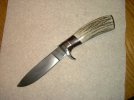Thanks Guys, got a lot going on right now, finaly got time to finish one.
DaQo'tah, I now get my steel from Rex Walter, forged down to 1" square bar.
I start forging at non magnetic till there is very little color left, and at no time does the steel get above criticle. Every 5-6 heat the bilit gets a flash normalize, heat to non-magnetic and let cool to a black heat, then back into the fire. After forging the blade it gets 7 back to back flash nornalizing cycles. Then I while forging the tange the whole blade gets heated to nonmagnetic and the blade portion gets 3 20 second quenchs in room temp. type A. After forging the tang out I do any straigting or tweaking of the blade then three full normilizing cycles to room temp, then I heat it back up to non-magnetic and place the blade between to pieces of 1/4" flatbar that I have heated to a red heat and put the whole thing in a bucket of wood ash to aneal. Next two days to more anealing cycles then to the belt grinder.
I finish the blade out to a 400 grit on the grinder leaving the edge about a 1/32"-1/16" thick. I heat the edge with a torch, starting at the ricasso since it's thicker and heat the lower 1/3 of the blade to just above non-magnetic and quench in type A at 150degF. Let the blade cool to room temp in the oil, then overnight in the frezzer. I take the blade out about an hour before the next quench. After the final quench(there are three of them, 24 hours apart) I leave the blade in the freezer for 24 hours before tempering. I temper the blade in a toaster oven at 375 for 3 2 hour cycles, letting the blade cool to room temp between tempers.
After tempering I sharpen and test the edge with a brass rod, if it passes, I go to the belt grinder and take to a 400 grit finish then start hand rubing with 320 grit to true everything up, then to a 600 grit cork belt loaded with green chrome buffing compound. I then test the blade and edge geomitry by cutting rope, hard wood and even chop into an old cow shin bone and just about anything else lying around the shop. After that I start hand rubing at 400 then 600 grit, then it's ready to etch.
I wash the blade with dish washing liquid in the sink to make sure there are no oils on it(hold blade by the tange to keep finger oils off blade), then dip in the etchant. I use 1 part feric chloride to 4-5 parts water. I have good tap water and havent' had a problem, but it may be necisary to use distilled water. After about 10 minits I give a light sanding with 1500 grit sandpaper while wet with the solution then back in for about 10 minits. I usally do this four times, then neutrulize by spraying down with windex. I then boil the whole thing in a can of bakeing soda and water for about 30 minits to help no only neutrulize the etchant but also to kill any flux from soldering the gaurd.
After that I give the blade a couple of light passes on a loose buffing wheel with eighther white or pink compound to brighten everything up. One thing I've notice about Rex's steel compared to my old bearing races is that after all this there is a faint pattern on the edge like damascus.
Hope I explained everything ok,
Will


